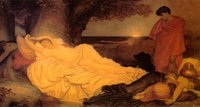Iphigeneia
|
|
- 112 Iphigenia is an asteroid.
300px-Iphigenia.jpg
Iphigeneia (gr. Ἰφιγένεια, also Iphigenia and sometimes Iphianassa) was a daughter of Agamemnon and Clytemnestra in Greek mythology. Iphigeneia is sometimes called a daughter of Theseus and Helen raised by Agamemnon and Clytemnestra.
Artemis punished Agamemnon after he killed a (sacred) deer in a (sacred) grove and boasted he was a better hunter. On his way to Troy to participate in the Trojan War, Agamemnon's ships were suddenly motionless as Artemis stopped the wind in Aulis. A soothsayer named Calchas revelead an oracle that the only way to appease Artemis was to sacrifice Iphigenia, Agamemnon's daughter, to Artemis. According to some versions he did so, but most sources claims that Iphigenia was taken by Artemis to Tauris in Crimea to prepare others for sacrifice, and that the goddess left a deer or a goat (the god Pan transformed) in her place. Hesiod called her Iphimedeia (gr. Ἰφιμέδεια) in the Catalogue of Women and told she became the goddess Hecate. Antoninus Liberalis said that Iphigeneia was transported to the island of Leuke, where she was wedded to Achilles under the name of Orsilochia.
According to Euripides, Iphigeneia factors into the story of her brother, Orestes. In order to escape the persecutions of the Erinyes for killing his mother Clytemnestra and her lover, he was ordered by Apollo to go to Tauris (now the Crimea), carry off the statue of Artemis which had fallen from heaven, and bring it to Athens. He repairs to Tauris with Pylades, son of Strophius and intimate friend of Orestes, and the pair are at once imprisoned by the Tauri, among whom the custom is to sacrifice all strangers to Artemis. The priestess of Artemis, whose duty it is to perform the sacrifice, is his sister Iphigenia. She offers to release Orestes if he will carry home a letter from her to Greece; he refuses to go, but bids Pylades take the letter while he himself will stay and be slain. After a conflict of mutual affection, Pylades at last yields, but the letter brings about a recognition between brother and sister, and all three escape together, carrying with them the image of Artemis. After their return to Greece, Orestes took possession of his father's kingdom of Mycenae and Argos and Iphigeneia left the image in the temple of Artemis in Brauron, Attica, where she remained as priestess of Artemis Brauronia. According to the Spartans, the image of Artemis was transported by them to Laconia, where the goddess was worshipped as Artemis Orthia.
Iphigeneia is known by Greek myths sources since 7-6th century BC and was so closely identified with Artemis that some scholars believe she was originally a rival hunting goddess whose cult was subsumed by Artemis.
| Contents |
Iphianassa
Iphianassa (gr. Ἰφιάνασσα), one of three Agamemnon's daughters in Homer's Iliad (Book 9, lines 145 and 287) is sometimes confused with Iphigeneia. Homer makes no mention to Iphigenia's sacrifice and the name Iphianassa may be simply an older variant of the name Iphigenia. Most scholars nevertheless agree that Iphianassa and Iphigeneia, despite the likeness of their names, probably were quite different characters.
Cymon and Iphigenia
The episode of Iphigenia and Cymon that inspired painters as Benjamin West (1773), John Everett Millais (1848) and Frederic Leighton (1884) is not really a Greek myth, but a novella taken from Boccaccio's Decameron, developed later by the poet and dramatist John Dryden.
The tale intended to demonstrate the power of love. As Iphigenia sleeps in a grove by the sea, a noble but coarse and unlettered Cypriot youth, Cymon, seeing Iphigenia's beauty, fell in love with her and, by the power of love, became an educated and polished courtier.
Some modern sources
BONNARD, A. Iphigénie à Aulis. Tragique et Poesie. Museum Helveticum, Basel, v. 2, p. 87-107, 1945.
CROISILLE, J.-M. Le sacrifice d’Iphigénie dans l’art romain et la littérature latine. Latomus, Bruxelles, v. 22, p. 209-225, 1963.
DECHARME, P. Iphigenia. In: DAREMBERG, C. & SAGLIO, E. Dictionnaire des Antiquités Grecques et Romaines, v. 3 (1ère partie), p. 570-572, 1877-1919.
JOUAN, F. Le Rassemblement d’Aulis et le Sacrifice d´Iphigénie. In: _______, Euripide et les Légendes des Chants Cypriens. Paris: Les Belles Lettres, p. 259-298, 1966.
KAHIL, L. Le sacrifice d’Iphigénie. In: 'Mélanges de l’École Française de Rome'. Antiquité, Rome, v. 103, p. 183-196, 1991.
KJELLBERG, L. Iphigeneia. In: PAULY, A.F. & WISSOWA, G. Real-Encyclopädie der Classischen Altertumswissenschaft. Stuttgart: J. B. Metzler, v. 9, p. 2588-2622, 1916.
LLOYD-JONES, H. Artemis and Iphigeneia. Journal of Hellenic Studies, London, v. 103, p. 87-102, 1983.
PECK, H.T. Iphigeneia. In: Harpers Dictionary of Classical Antiquities. New York: Harper and Brothers, 1898.
SÉCHAN, L. Le Sacrifice d’Iphigénie. Révue des Études Grecques, Paris, p. 368-426, 1931.
WEST, M.L. The Hesiodic Catalogue of Women. Oxford: Clarendon Press, 1985.
Some adaptations of the Iphigenia story
- Iphigenia at Aulis, play by Euripides.
- Iphigénie en Aulide, play by Jean Racine.
- Iphigenia in Aulis]], opera by Christoph Willibald Glück.
- Iphigenia in Tauris, play by Euripides.
- Iphigenia in Tauris, play by Johann Wolfgang von Goethe.
- Iphigenia in Tauris, opera by Christoph Willibald Glück.
- Iphigénie, ballet by Charles le Picq.
- The Songs of the Kings, novel by Barry Unsworth.de:Iphigenie
es:Ifigenia fr:Iphigénie it:Ifigenia (mitologia) nl:Iphigenia pl:Ifigenia

